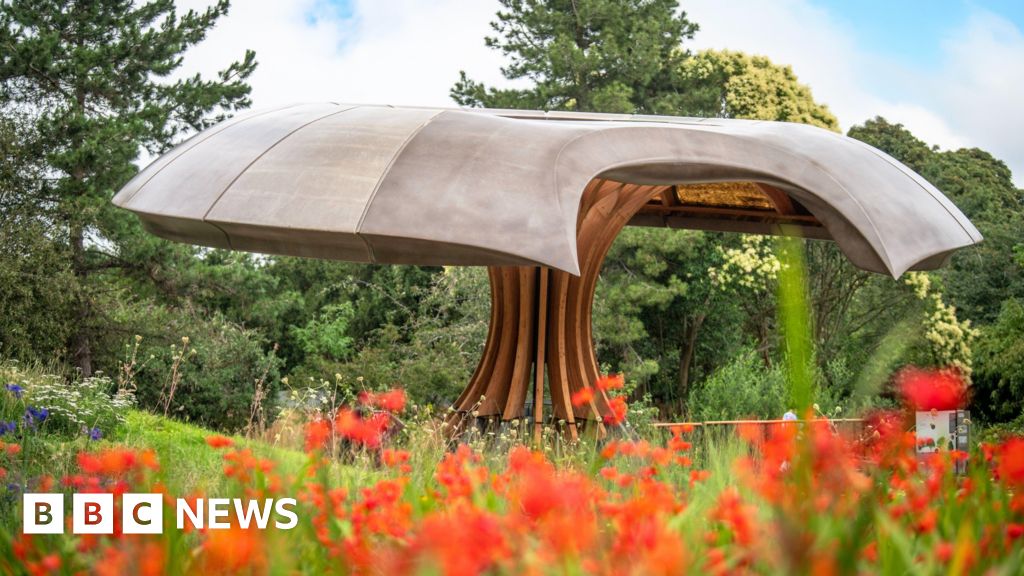The UK’s Kew Gardens is unveiling a floral call to climate action by showcasing how plants, trees, fungi and soils in gardens might help store carbon while illuminating measures to help them survive rising temperatures and extreme weather now and in the future
A unique, environmentally provocative, horticultural installation is being unveiled to the public tomorrow (25 July) at one of the world’s most prestigious scientific institutions, the Royal Botanic Gardens (RBG) Kew in southwest London.
The Carbon Garden is designed to be a thing of beauty but also an explicit statement of the reality now facing legions of green-fingered enthusiasts worldwide: namely that climate change is turning both the world and the potting shed upside down.
Opening 25 July 2025, Kew’s innovative new Carbon Garden will not only showcase the essential role plants and fungi play in tackling climate change but will also highlight how our gardens will have to change in the future --RGB KewFor visitors, perhaps the most striking, initial, feature will be the garden’s pavilion which has been created by the Mizzi Studio led by Maltese-born Jonathan Mizzi who is both a designer as a well as passionate advocate for climate action.

The fungi-style pavillion in Kew garden's new Carbon Garden designed using natural materials by ... More Mizzi Studio
Mizzi StudioThe pavilion is inspired by the symbiotic relationship between the plant and fungal kingdoms, and is created using low-carbon, natural materials.
The deliberate echo of fungi in the design in part reflects how science has recently and rapidly understood the role fungi play in feeding plants and protecting them from pests, but also their pivotal role in fostering healthy soils and capturing vast amounts of carbon.
By one recent estimate from Australian scientists, mycorrhizal fungi underground may be abs0rbing as much as 75 per cent of the annual carbon emissions from the fossil fuel industry.
The pavilion also has a roof designed to capture and funnel water into a rain garden, underlining as climate change deepens, better management of water is going to be crucial for plants and humans.
Another striking feature in the Carbon Garden is the way colourful plants have been arranged to reflect how temperatures have changed since the birth of the industrial revolution.
The “stripes”, which change from cool blues to hot reds, starkly reflect how climate change is driving a warmer world.
The bar-code like colours have become expressions of concern and solidarity on campaigners’ T shirts to coffee mugs and web sites since they were created by University of Reading scientist Professor Ed Hawking in 2018.
Richard Wilford, head of Garden Design at RBG Kew and the person behind the new garden’s design, told the BBC that the “stripes” flower bed and other features are a “unique opportunity to showcase our ongoing research, combining scientific insight with thoughtful design and beautiful planting".
The Carbon Garden also has borders where plants need to tolerate, and encouraged to evolve, to the Mediterranean like conditions that could soon prevail in southern England if nations fail to meet the safety limits of the 2015 Paris Climate Agreement.
Research has revealed that the conditions of London might be like Barcelona in Spain by 2050. The research indicates that species like cherry hackberry (Celtis cerasifera), native to China, Montezuma's pine (Pinus montezumae), native to Central America, and spoon oak (Quercus urbani), native to Mexico should withstand projected climate conditions.
And this has informed the planting of new trees as part of the Carbon Garden that should, based on the studies, thrive well into the 2090s.
Already some scientists are warning that the top safety target of the Paris global agreement—to keep an average temperature rise world-wide no higher than 1.5 degrees C—may be lost in just a handful of years without rapid, scaled up action.
Could gardeners become a new and powerful voice for climate action alongside more traditional campaigners like Friends of the Earth, Greenpeace, Fridays for Future and WWF?
Only time will tell. But they certainly represent a large group in certain key countries. By some estimates there are 27 million gardeners in the UK alone. Other surveys suggest around a third to just over 40 per cent of households in the UK, Austria, Australia, Germany and the United States of America are gardeners.
Mr Wilford says inspiring action is a key part of the Carbon Garden’s aim: “How we adapt to this changing climate and how we can slow the rate of climate change are important messages in the Carbon Garden”.
Throughout the garden there are ideas that we hope will inspire people to help, from planting resilient trees and drought tolerant plants, to encouraging biodiversity and forming rain gardens to slow the rate of runoff during periods of heavy rainfall. The garden is filled with plants that enhance these stories--Richard Wilford, Head of Garden Design, KewRichard Wilford, head of garden design at the Royal Botanic Gardens Kew
RBG Kew"Kew hopes that the Carbon Garden will inspire similar ideas in other countries. Towns and cities that are already having to deal with catastrophic weather events are having to find solutions quickly. By encouraging people and authorities to be proactive, it may be possible to lessen the more extreme consequences of climate change,” he added.
The Carbon Garden is not Kew’s only commitment to climate action and awareness building.
It already has pledged to go beyond net zero and achieve a climate positive profile for its operations by 2030. As part of this aim, Kew Gardens has also announced plans to restore two of its popular and iconic heritage buildings to help meet its climate goals.
Kew’s Palm House and Waterlily House, originally dating from the 19C will see the replacement of 16,500 glass panes with high-performance sealed glazing and the use of bespoke silicone gaskets to reduce heat loss.
There will also be the installation of a fully electrified air and water source heat pump systems alongside upgrades of the rainwater storage and irrigation systems to both build reslience against extreme weather and climate change risks.









 English (US) ·
English (US) ·